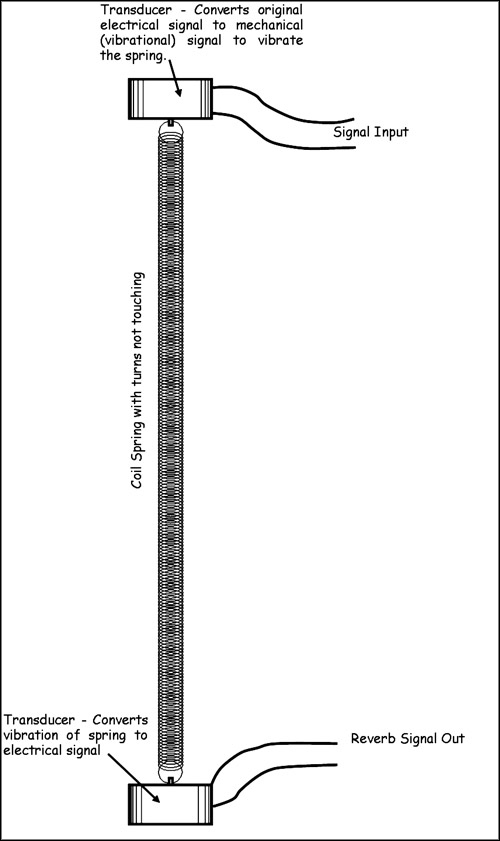The HAMMOND ORGAN
North Suburban HAMMOND ORGAN Service

Figure 27. This diagram shows, in simplified form, the basic elements of an artificial reverberation unit based upon a coil spring. To be effective, the wire from which the spring is wound should be of fairly small gauge, and the individual turns of the spring must not touch each other.
At the top of the spring, a transducer converts the incoming electrical signal from the console to a mechanical signal which is applied to the spring, vibrating it slightly. In actual practice, the vibrations are very minute. You would not see anything moving or vibrating if you watch the unit in action.
At the other end, a similar transducer converts the minute mechanical vibrations in the spring back to an electrical signal which is then mixed with the original signal and the composite goes to a power amplifier and then to the speakers.
Figure 27A, below. This animated diagram shows, in simplified form, what happens when a brief signal is introduced into a single spring reverb device. The signal starts at the top (brief sine wave), and travels down the spring as shown. At the bottom transducer, the mechanical signal in the spring is converted to an electrical signal and exits as shown by the smaller sine wave there. Because very little mechanical energy is lost, most of the mechanical signal bounces back up the spring where it is reflected a second time and travels back down the spring to the output transducer. Notice that the signal from the transducer gradually fades, as the spring continues to reflect and sustain the signal. Notice also that with successive repetitions, the attack of the repeat echo signals becomes more gradual, so in effect the spring is doing several things. It is reflecting the original signal back and forth along its length and it also degrades the definition of the repeats and fades the signal as well. The audible effect of such a reverb device with a brief, sharp sound introduced would be a series of repeats but each repeat will also have some additional sustaining of the signal and progressively less definition.

While this is somewhat of an oversimplification, it shows how the reverb spring both repeats and gradually fades and blurs the signal producing the effect of a pronouced echo with some reverb as well. To keep it simple, this diagram shows just three repetitions. A single spring like this would actually reverberate a signal for a much longer time and would probably need some sort of damping applied to make it practical. The main point here is that a suitable spring of a convenient length can be used to add echo, reverb and delay to an audio signal. In practice such a spring would be not much over two feet in length.
If you play a Hammond organ in a large, reverberant room, the room acoustics will, during the buildup of the room's natural reverberation, slightly soften the attacks of the tones, and the reverberation will provide both a sustaining action and a gradual decay, this essentially eliminating the Hammond's instant-on, instant-off characteristics. Hammond to a significant degree overcame the key click problem by designing their amplifiers and speaker systems to be effective only up to 6kHz which is the highest frequency that the instrument can produce. There is no need to go beyond that. The key clicks, on the other hand, consist of a very short burst of high frequencies going right up to the limit of human hearing. Therefore, by making the amplification and speaker system unresponsive above the highest notes or pitches that the instrument can produce, the key clicks can be made less noticeable. However, if a Hammond went to a small room rather than a large, reverberant room, the instant-on, instant-off characteristic would still be a problem.
Hammond engineers therefore developed an artificial reverberation unit whose purpose was to create a reverberation effect such as that which you would encounter in a large room or hall, and to apply this effect to the signals at the speaker cabinets, thereby overcoming what was otherwise a real problem.
Hammond discovered that you could use coil springs to simulate reverberation. In order to do this, there has to be a transducer at each end of the spring. At one end, the electrical signal goes in and gets converted to mechanical energy, which in this system literally shakes or vibrates the spring in an exact replica of the electrical signal fed into it. At the other end, a similar transducer converts the mechanical motion of the spring back to electrical energy, thereby developing an electrical signal that copies the vibration of the spring.
Because these mechanical vibrations travel relatively slowly in a spring, you do not need a spring more than perhaps two to three feet long to introduce a delay in the sound, similar to an acoustic echo in a room. Furthermore, at each end of the spring, the signal (mechanical vibration at this point) gets reflected back and forth along the spring, thus the spring sustains or reverberates the signal as large rooms and halls do with their multiple echoes that blend together to form a smooth reverberation effect.
The pictures on this page are diagrammatic representations of a single spring used as an artificial reverberation producer.
Although seemingly simple in principle, there are a number of important criteria which must be met in order for a spring reverb unit to be successful. The earliest Hammond reverb units were just borderline, but they were a decided improvement when you compare them with the use of no such device in a small room.
One of the biggest problems that we would encounter with a single spring reverb device is that of the mechanical resonances in such a spring. If a given note from the instrument has a frequency that is close to a natural resonant frequency in the spring, then the spring will make that particular note somewhat to much louder than other notes. The opposite is also true. If a particular note is of a frequency that the spring does not "like", the spring can reduce the signal level. Also if the phase of a signal at the output of the spring should be opposite to the phase of the direct signal, this can virtually completely cancel or eliminate that note. The mass of the early Hammond reverb unit parts was great enough that these units would respond very poorly to the highest frequency signals that the console would put out which made the reverb unit much less effective that it should be. While Laurens Hammond himself was said to be somewhat tone deaf or at least not cognizant of some of the finer points of musical sound, he had people working for him who were, and they soon began to experiment and there is a significant difference between the performance of Hammond's very earliest reverb devices and those made even a few years later.
The people at the Hammond Co. continued to make many improvements to these early reverb units, but eventually, they scrapped the original design and developed a much different spring reverb deice which was a huge improvement over the original ones. But the earliest Hammond reverb units were still a decided improvement when compared to using a Hammond in a small room with NO such device present.
Previous page Page 16. Next page